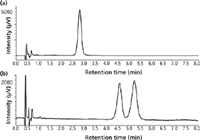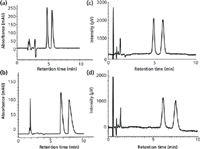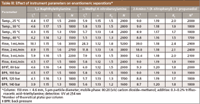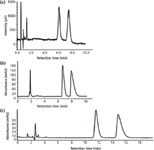Comparison of Enantiomeric Separations and Screening Protocols for Chiral Primary Amines by SFC and HPLC
LCGC North America
Supercritical (subcritical) fluid chromatography (SFC) was evaluated as an alternative to HPLC for the enantiomeric separation of primary amines on a cyclofructan-based chiral stationary phase.
Supercritical (subcritical) fluid chromatography (SFC) was evaluated as an alternative to high performance liquid chromatography (HPLC) for the enantiomeric separation of primary amines on a cyclofructan-based chiral stationary phase. The effect of various organic modifiers, acidic and basic additives, as well as instrumentation-specific parameters such as column temperature, flow rate, and back pressure were evaluated. The results were compared to normal-phase and polar organic modes.
Supercritical fluids were introduced as mobile phases in chromatographic separations by Klesper and colleagues in the 1962 (1). While capillary-based methods did not become widely utilized, packed-column supercritical (subcritical) fluid chromatography (SFC) has become increasingly common over the last 15 years (2–5). In the last decade, many of the hardware shortcomings have been improved and instrumentation for both analytical and preparative separations are readily available (6,7). The advantages of SFC are particularly pronounced in the field of chiral separations where many commonly used stationary phases provide optimal separations in the normal-phase mode (7–10). Now, with an impetus for "green separations" and high-throughput screening, SFC has become the platform of choice for many pharmaceutical companies, where speed is an essential aspect of method development (6,11,12). Higher flow rates without concomitant loss of column efficiency as well as lower solvent consumption are two of the major advantages of adopting SFC-based separations (5,6). Despite being commonly referred to as supercritical fluid chromatography, better separations are often obtained under subcritical conditions because of the improvements achieved by using a polar modifier such as methanol in combination with carbon dioxide (10,13,14). Regardless of the state of the carbon dioxide–modified mobile phase, separations utilizing SFC instrumentation with modified carbon dioxide mobile phases are most commonly referred to as SFC separations. Carbon dioxide has a polarity similar to pentane and can replace the nonpolar solvent in normal-phase methods, thus allowing them to be easily transferred to SFC instrumentation and vice versa (10,15,16). Short columns combined with high flow rates allow for rapid evaluation of multiple chiral stationary phases (CSPs) using multiple organic modifiers in a short period of time (17). When screening multiple CSPs and mobile-phase combinations, baseline resolution is not mandatory and analysis times can often be reduced to less than 10 min (17). By incorporating column and mobile-phase switching systems, what would typically take a technician days can often be reduced to hours. Advantages abound at the preparative scale as well since the major component of the mobile phase, which requires no evaporative step, and the low viscosity of carbon dioxide allows for high flow rates (18).

The use of crown-ether based chiral stationary phases to separate primary amine racemates was introduced in 1978 by Cram and colleagues (19). Since then, several crown ether–based CSPs have been developed and evaluated (20–24). These reversed-phase CSPs suffer from the need to operate under acidic aqueous conditions and are therefore not suitable for use with carbon dioxide mobile phases and are not advantageous for preparative scale separations.
A relatively new class of immobilized chiral selectors based on derivatized cyclofructans (CFs) have been shown to provide excellent selectivity toward a variety of racemic compounds (25–33). Cyclofructans also possess crown ether moieties with 6–8 pendant fructofuranose units. After it is derivatized with isopropylcarbamate groups, CF6 can separate a variety of primary amines without the need for aqueous mobile phases (25). However, no comprehensive study on its use under SFC conditions has been performed.
In this work, the Larihc CF6-P CSP was evaluated as a chiral selector under SFC conditions using 25 chiral primary amine probe analytes. These chromatographic results were compared to normal-phase conditions (hexane and ethanol) as well as polar organic conditions (acetonitrile and methanol). These three modes represent the most useful chromatographic conditions for many commonly used CSPs and a comparison of these modes will aid in developing future chiral methods using this CSP.
In SFC, the polar modifiers methanol, ethanol, and 2-propanol were evaluated using three probe analytes with short, intermediate, and long retention. Various acidic and basic additives and additive combinations were evaluated under similar mobile phase conditions. The advantages of using a combination of additives instead of individual acid or base additives include improved peak shapes, shorter retention times, and suppression of nonspecific interactions (34). Based on the collective data, recommended screening conditions are provided for SFC, normal-phase, and polar organic separations.
Experimental
Materials
High performance liquid chromatography (HPLC)-grade hexane, methanol, ethanol, 2-propanol, and acetonitrile were purchased from Fisher Scientific. ACS-grade acetic acid, ammonium hydroxide (37% w/w), trifluoroacetic acid, triethylamine, butylamine, diisopropylamine, and diethylamine were purchased from Sigma-Aldrich. A Larihc CF6-P HPLC column (150 mm × 4.6 mm, 5-μm particle diameter) was obtained from AZYP LLC.
Chiral Test Compounds
(S)-(-)-1-(2-Naphthyl)ethylamine, (R)-(+)-1-(2-naphthyl)ethylamine, (1R,2R)-(-)-2-amino-1-(4-nitrophenyl)-1,3-propanediol, (1S,2S)-(+)-2-amino-1-(4-nitrophenyl)-1,3-propanediol, (1R,2S)-(+)-cis-1-amino-2-indanol, (1S,2R)-(-)-cis-1-amino-2-indanol, (1R,2R)-(-)-trans-1-amino-2-indanol, (1S,2S)-(+)-trans-1-amino-2-indanol, α-methyl-4-nitrobenzylamine hydrochloride (±), α-methylbenzylamine (±),1,2-diphenylethylamine (±),norphenylephrine hydrochloride (±), DL-4-chlorophenylalaninol, normetanephrine hydrochloride (±), norephedrine hydrochloride (±), octopamine hydrochloride (±), trans-2-phenylcyclopropylamine hydrochloride (±), (1S,2R)-(+)-phenylpropanolamine, (1R,2S)-(-)-phenylpropanolamine, (R)-(-)-2-phenylglycinol, (S)-(+)-2-phenylglycinol, (S)-(-)-2-amino-3-phenyl-1-propanol, (R)-(+)-2-amino-3-phenyl-1-propanol, 1-(1-naphthyl)ethylamine (±), (1S,2S)-(+)-2-amino-1-phenyl-1,3-propanediol, (1R,2R)-(-)-2-amino-1-phenyl-1,3-propanediol, (S)-(-)-2-amino-1,1-diphenyl-1-propanol, (R)-(+)-2-amino-1,1-diphenyl-1-propanol, (1R,2S)-(-)-2-amino-1,2-diphenylethanol, (1S,2R)-(+)-2-amino-1,2-diphenylethanol, (S)-(-)-2-amino-3-methyl-1,1-diphenylbutane, (R)-(+)-2-amino-3-methyl-1,1-diphenyl-butane, (R)-(+)-2-amino-4-methyl-1,1-diphenylpentane, (S)-(-)-2-amino-4-methyl-1,1-diphenylpentane, α-methyl-DL-phenylalanine methyl ester hydrochloride, (S)-(-)-1,1'-binaphthyl-2,2'-diamine, (R)-(+)-1,1'-binaphthyl-2,2'-diamine, (R)-(+)-2-amino-1,1'-binaphthalen-2-ol, (S)-(-)-2-amino-1,1'-binaphthalen-2-ol, (R)-(+)-1,1-diphenyl-2-aminopropane, (S)-(-)-1,1-diphenyl-2-aminopropane, DL-alanine β-naphthylamide hydrochloride, methoxamine hydrochloride (±), 1-aminoindan (±) were purchased from Sigma-Aldrich.
HPLC Methods
All HPLC analyses were performed on an Agilent 1260 Infinity HPLC system that included a degasser, a quaternary pump, an autosampler, a column thermostat, and a diode-array detector. Data analysis was carried out using OpenLAB CDS Chemstation Edition Rev. C.01.04. Flow rates were held at 2 mL/min unless otherwise noted. Normal-phase separations were carried out using hexane with ethanol as a polar modifier in the range of 5–30% (v/v). Polar organic mode separations were carried out using acetonitrile with methanol as a polar modifier in the range of 5–20% (v/v).
SFC Methods
A Jasco 2000 series SFC (SFC-2000-7) equipped with a carbon dioxide pump (PU-2086), a modifier pump (PU-2086), a back-pressure regulator (BP-2080), an autosampler (AS-2059-SFC), a column oven (CO-2060), a variable-wavelength detector (UV-2075), and a makeup pump (PU-2080) supplying additional methanol to the back-pressure regulator was used for all SFC analyses. The carbon dioxide pump was chilled to -10 °C using a Julabo chiller. The back-pressure regulator was maintained at 60 °C. Instrument operation and data analysis was conducted using ChromNAV via an LC-NET II/ADC. The flow rate was held at 4 mL/min unless otherwise noted. Methanol, ethanol, and 2-propanol were used in the range of 2–40% (v/v). Acidic and basic additives were used in the range of 0.1–3% (v/v).
Universal Parameters
Samples were prepared in ethanol at 1 mg/mL. All injections were 5 μL. Column temperature was held at 30 °C unless otherwise noted. UV detectors were operated at 254 nm.
Results and Discussion
Effect of Additives
Table I provides data that allows comparison of the effects of various acidic and basic additives using three probe analytes and otherwise common chromatographic conditions. The common SFC additive, ammonium hydroxide, was evaluated at 0.2% (v/v) in methanol, and absolutely no selectivity was observed (Figure 1). Indeed, it was clear from these studies that ammonium ion negates enantioselectivity and therefore should not be used with these stationary phases. When switching to 0.2% triethyamine, moderate selectivity was observed for two of the probe analytes, but none could be baseline separated. Under acidic conditions when using trifluoroacetic acid at 0.3%, excellent selectivity was observed, but significant peak asymmetry resulted in no baseline separations. By using a combination of trifluoracetic acid and triethylamine at 0.3%, 0.2% (40 mM trifluoracetic acid, 15 mM triethylamine in methanol, 8 mM trifluoracetic acid, 3 mM triethylamine overall) respectively, excellent selectivity and peak shapes were observed with two baseline separations. A likely explanation for the need for trifluoracetic acid is that chiral recognition is improved when analytes are ionized and interact more favorably with the chiral selector and by adding a competitive organic amine (triethylamine), mass transfer kinetics are improved and sharper peak profiles are obtained. Minor changes in retention and selectivity are observed when using alternate organic amines such as diethylamine, diisopropylamine, and butylamine. However, none provided greater resolutions than triethylamine. It appears that the smaller ammonium group most likely complexes too strongly with the chiral selector which inhibits chiral recognition between the derivatized cyclofructan and the probe analytes. Further evidence of this is provided by using a combination of trifluoracetic acid and ammonium hydroxide where retention is strongly attenuated and selectivities are very poor. When using a combination of acetic acid and triethylamine, retention times were increased and selectivities were lower compared to trifluoracetic acid and triethylamine at the same concentration. Previous studies using polar organic chromatographic conditions show that a 3:2 (v/v) acid:base ratio provides optimal separation conditions (30). This was confirmed for SFC by also testing 2:2 and 4:2 (v/v) acid:base combinations for the separation of three test analytes. Overall, selectivity and resolution values were always at a maximum value when the acid:base ratio was at 3:2 (v/v). For example, when 1,2-napthylethylamine was screened using the 3:2 acid:base ratio, selectivity and resolution values were 1.13 and 1.5, respectively. However, when 2:2 and 4:2 acid:base ratios were used to separate 1,2-napthylethylamine, selectivity and resolution decreased, in both cases, to 1.11 and 1.2, respectively. In SFC, the effect of holding the ratio constant and varying the total concentration of the additives was that increasing the amount of additives shortened retention and improved efficiencies, but with minimal improvement in selectivity or resolution (Figures 2c and 2d). This is not the case when operating under polar organic conditions where increasing the concentration of the additives improved peak symmetries and reduced analysis time with minimal loss of selectivity (Figures 2a and 2b). This is likely because of the higher diffusivity of carbon dioxide relative to acetonitrile and overall improved mass transfer kinetics relative to polar organic or normal phase conditions. Based on the combined results, the recommended additive for screening primary amines in SFC is 0.3–0.2% (v/v) in methanol. When operating under polar organic or normal phase conditions, it is possible to either premix the mobile phases or put additives in the separate mobile phase reservoirs (for example, in hexane and ethanol for normal-phase chromatography or in acetonitrile and methanol in the polar organic mode) and let the instrument mix the two solvents in the desired proportions. Regardless of one's approach, the overall additive concentration in the eluent should be 0.3–0.2% (v/v) trifluoracetic acid–triethylamine for normal phase or polar organic mode separations.

Table I: Effect of additives on enantiomeric separations*
Effect of Polar Modifier
Different commonly used organic modifiers for SFC were evaluated at 25% (v/v) with 0.3%, 0.2% trifluoracetic acid, triethylamine and the results are reported in Table II. The general trend for SFC was that as larger alcohol modifiers were used, selectivities were often improved, but mass transfer kinetics were significantly diminished resulting in low plate numbers and pronounced peak tailing. Resolutions were lower for all probe analytes in all cases when changing the organic cosolvent from methanol. Plate numbers dropped precipitously when going from methanol to 2-propanol. Based on these results, methanol is recommended as the polar modifier of choice when screening primary amines using the Larihc CF6-P CSP in SFC. The added advantage of increased organic modifier volatility, when dealing with preparative separations, provides additional impetus for using methanol when developing chiral SFC methods.

Figure 1: Effect of additives on retention and selectivity. Analyte: 1,2-naphthyethyamine; mobile phase: 80:20 (v/v) carbon dioxideâmethanol; flow: 4 mL/min; (a) 0.2% (v/v) ammonium hydroxide; (b) 0.3â0.2% (v/v) trifluoroacetic acidâtriethylamine.
Effect of Column Temperature, Flow Rate, and Back Pressure Under Subcritical Conditions
The same three probe analytes used in the "additive study" were used to evaluate the effect of column temperature at 25 °C, 30 °C, 35 °C, and 40 °C using 25% methanol with 0.3%, 0.2% trifluoracetic acid, triethylamine (Table III). As the column temperature was increased, the selectivity and resolution diminished without significant improvement in the analysis time. Interestingly, the highest temperature did not improve efficiency, indicating that under these mobile-phase conditions, mass transfer kinetics are not hindered by operating at subcritical temperatures. The loss of resolution observed by going from 30 °C to 40 °C was significant enough to merit operating at 30 °C. Given the necessity of having a considerable polar modifier to elute the analytes from the CSP (15–30% v/v) and the fact that resolutions were diminished at elevated temperatures, no effort was made to operate under true supercritical conditions as chromatographic performance would certainly be compromised at the temperatures and pressures necessary to reach the critical point.

Figure 2: Effect of additive concentration on retention, selectivity, and peak symmetry. Analyte: (RS/SR) 2-amino-1,2-diphenylethanol; chromatograms (a) and (b): 90:10 acetonitrileâmethanol; flow: 1 mL/min. (a) 0.3â0.2% (v/v) trifluoroacetic acidâtriethylamine (overall), (b) 0.3â0.2% (v/v) trifluoroacetic acidâtriethylamine (methanol only). Chromatograms (c) and (d): mobile phase 80:20 carbon dioxideâmethanol; flow: 3 mL/min. (c) 0.3â0.2% (v/v) trifluoroacetic acidâtriethylamine (overall), (d) 0.3â0.2% (v/v) trifluoroacetic acidâtriethylamine (methanol only).
Flow rates of 1-, 2-, 3-, and 4-mL/min were evaluated to study the effects of operating at higher linear mobile-phase velocities. The results also are presented in Table III. When going from 1 mL/min to 4 mL/min, plate counts were reduced by approximately 40% without a loss of selectivity. Resolutions were higher at 1 mL/min, but came with an obvious cost of analysis time. Because selectivities were not lower at higher linear velocities and plate counts were still acceptable, 4 mL/min is the recommended flow rate for screening.

Table II: Effect of polar modifier on enantiomeric separations*
A similar study was performed by analyzing the three probe analytes with the back-pressure regulator set at 80, 100, 120, and 140 bar. The effect was a moderate decrease in retention time at higher pressure with minor loss of selectivity and resolution. Minor losses in plate count were observed by increasing the column back pressure and thus a recommended back pressure of 100 bar seemed acceptable.

Table III: Effect of instrument parameters on enantiomeric separations*
Comparison Between SFC, Normal-Phase, and Polar Organic Modes
Table IV gives the chromatographic results for the separation of 25 racemic primary amines under SFC, polar organic, and normal-phase modes. In general, SFC provided the best peak symmetries, while the polar organic mode provided the shortest analysis times and the normal phase provided the greatest resolutions at a cost of analysis time (Figure 3). Under SFC conditions, 16 out of 25 analytes were baseline separated in the screen while the polar organic and normal-phase modes provided 13 and 17 baseline separations, respectively. In total, the SFC screen showed enantioselectivity for all but three of the tested analytes. It should be noted that, for comparative purposes, trifluoracetic acid and triethylamine were only added to the polar modifier in the polar organic and normal-phase modes. In practice however, it is recommended to make the overall concentration 0.3–0.2% (v/v) trifluoracetic acid–triethylamine when using either the polar organic mode or normal phase. This will result in more baseline separations when using HPLC because of improved peak symmetries, particularly when operating under polar organic conditions (as discussed earlier and shown in Figure 2).

Table IV: Chromatographic data for enantiomeric separations under SFC, polar organic (POM), and normal-phase (NP) screening conditions*
Acetonitrile provided the greatest eluotropic strength followed by hexane, with carbon dioxide having the lowest strength. Retention factors were always highest for SFC separations even when operating at a greater percentage of methanol relative to the polar organic mode. Because the normal-phase separations were conducted using ethanol instead of methanol as a polar modifier, direct comparisons of retention factors for normal phase and SFC are not possible, however, normal-phase retention factors under the tested conditions were always intermediate relative to SFC and polar organic modes.

Figure 3: Comparison of SFC, polar organic, and normal-phase modes. Analyte: RS/SR 2-amino-1,2-diphenylethanol, chromatogram (a) mobile phase: 80:20 carbon dioxideâmethanol; flow: 3 mL/min; (b) 90:10 acetonitrileâmethanol, flow: 1 mL/min; (c) 80:20 hexaneâethanol; flow: 1 mL/min; all chromatograms 0.3â0.2% (v/v) trifluoroacetic acidâtriethylamine (polar modifier only).
Conclusions
SFC was evaluated as an alternative to HPLC for the separation of primary amines using the CF6-P chiral stationary phase. Using ammonium hydroxide as a basic additive destroys enantioselectivity. However, using methanol as a polar modifier with 0.3–0.2% (v/v) trifluoracetic acid–triethylamine as additives, excellent selectivity was observed with 18 baseline separations and 22 hits out of 25 probe analytes under general screening conditions. When compared to normal-phase chromatography and polar organic mode chromatography using the same CSP, SFC showed comparable selectivities and analysis times as well as improved peak symmetries. The recommended mobile phases for screening chiral primary amines in the polar organic and normal-phase modes are 90:10 acetonitrile–methanol and 80:20 hexane–ethanol, respectively, with an overall concentration of 0.3–0.2% (v/v) trifluoracetic acid–triethylamine. In general, additional optimization of the mobile-phase composition further enhances the selectivity and resolution of all analytes as compared to the screening solvent.
Acknowledgments
Research reported in this publication was supported by the National Institute of General Medical Sciences of the National Institutes of Health under award number R44GM103359. The content is solely the responsibility of the authors and does not necessarily represent the official views of the National Institutes of Health.
References
(1) E. Klesper, A.H. Corwin, and D.A. Turner, J. Org. Chem. 27, 700 (1962).
(2) R.C. Kong, S.M. Fields, W.P. Jackson, and M.L. Lee, J. Chromatogr. A 289, 105 (1984).
(3) T.A. Berger, J. Chromatogr. A 785, 3 (1997).
(4) M. Johannsen, J. Chromatogr. A 937, 135 (2001).
(5) K.W. Phinney, Anal. Bioanal. Chem. 382, 639 (2005).
(6) J.M. Plotka, M. Biziuk, C. Morrison, and J. Namieśnik, TrAC, Trends Anal. Chem. 56, 74 (2014).
(7) K. Kalíková, T. Šlechtová, J. Vozka, and E. Tesařová, Anal. Chim. Acta 821, 1 (2014).
(8) B. Chankvetadze, Methods Mol. Biol. 970, 81 (2013).
(9) Y. Liu, R.V. Rozhkov, R.C. Larock, T.L. Xiao, and D.W. Armstrong, Chromatographia 58, 775 (2003).
(10) Y. Liu, A. Berthod, C.R. Mitchell, T.L. Xiao, B. Zhang, and D.W. Armstrong, J. Chromatogr. A 978, 185 (2002).
(11) K. De Klerck, Y. Vander Heyden, and D. Mangelings, J. Chromatogr. A 1328, 85 (2014).
(12) W. Ren-Qi, O. Teng-Teng, N. Siu-Choon, and T. Weihua, TrAC, Trends Anal. Chem. 37, 83 (2012).
(13) G. Terfloth, J. Chromatogr. A 906, 301 (2001).
(14) Q. Sun and S.V. Olesik, Anal. Chem. 71, 2139 (1999).
(15) S.C. Moldoveanu and V. David in Essentials in Modern HPLC Separations, S.C. Moldoveanu and V. David, Eds. (Elsevier, 2013), p. 363.
(16) J. Vozka, K. Kalíková, C. Roussel, D.W. Armstrong, and E. Tesařová, J. Sep. Sci. 36, 1711 (2013).
(17) M. Maftouh, C. Granier-Loyaux, E. Chavana, J. Marini, A. Pradines, Y.V. Heyden, and C. Picard, J. Chromatogr. A 1088, 67 (2005).
(18) L. Toribio, M.J. del Nozal, Y.L. Bernal, C. Alonso, and J.J. Jimenez, J. Sep. Sci. 31, 1307 (2008).
(19) L.R. Sousa, G.D.Y. Sogah, D.H. Hoffman, and D.J. Cram, J. Am. Chem. Soc. 100, 4569 (1978).
(20) T. Shinbo, T. Yamaguchi, K. Nishimura, and M. Sugiura, J. Chromatogr. A 405, 145 (1987).
(21) Y. Machida, H. Nishi, K. Nakamura, H. Nakai, and T. Sato, J. Chromatogr. A 805, 85 (1998).
(22) H. Nishi, K. Nakamura, H. Nakai, and T. Sato, J. Chromatogr. A 757, 225 (1997).
(23) M.H. Hyun, J.S. Jin, and W. Lee, J. Chromatogr. A 822, 155 (1998).
(24) M. Hilton and D.W. Armstrong, J. Liq. Chromatogr. 14, 9 (1991).
(25) P. Sun, C. Wang, Z.S. Breitbach, Y. Zhang, and D.W. Armstrong, Anal. Chem. 81, 10215 (2009).
(26) J.P. Smuts, X.-Q. Hao, Z. Han, C. Parpia, M.J. Krische, and D.W. Armstrong, Anal. Chem. 86, 1282 (2013).
(27) P. Sun, C. Wang, N.L.T. Padivitage, Y.S. Nanayakkara, S. Perera, H. Qiu, Y. Zhang, and D.W. Armstrong, Analyst 136, 787 (2011).
(28) T. Gondová, J. Petrovaj, P. Kutschy, and D.W. Armstrong, J. Chromatogr. A 1272, 100 (2013).
(29) L. Janečková, K. Kalíková, J. Vozka, D.W. Armstrong, Z. Bosáková, and E. Tesařová, J. Sep. Sci. 34, 2639 (2011).
(30) P. Sun and D.W. Armstrong, J. Chromatogr. A 1217, 4904 (2010).
(31) R.M. Woods, D.C. Patel, Y. Lim, Z.S. Breitbach, H. Gao, C. Keene, G. Li, L. Kürti, and D.W. Armstrong, J. Chromatogr. A 1357, 172–181 (2014).
(32) N.L.T. Padivitage, E. Dodbiba, Z.S. Breitbach, and D.W. Armstrong, Drug Test. Anal. 6, 542–551 (2014).
(33) S. Perera, Y.-C. Na, T. Doundoulakis, V.J. Ngo, Q. Feng, Z.S. Breitbach, C.J. Lovely, and D.W. Armstrong, Chirality 25, 133 (2013).
(34) K. De Klerck, D. Mangelings, D. Clicq, F. De Boever, and Y. Vander Heyden, J. Chromatogr. A 1234, 72 (2012).
Ross M. Woods is with The University of Texas at Arlington, in Arlington, Texas. Zachary S. Breitbach is with The University of Texas at Arlington. Daniel W. Armstrong is with The University of Texas at Arlington and AZYP LLC, in Arlington, Texas. Direct correspondence to: sec4dwa@uta.edu

Common Challenges in Nitrosamine Analysis: An LCGC International Peer Exchange
April 15th 2025A recent roundtable discussion featuring Aloka Srinivasan of Raaha, Mayank Bhanti of the United States Pharmacopeia (USP), and Amber Burch of Purisys discussed the challenges surrounding nitrosamine analysis in pharmaceuticals.













